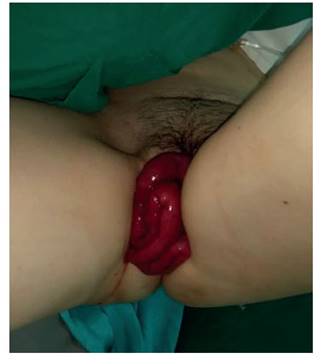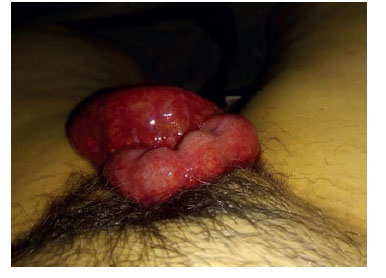Servicios Personalizados
Revista
Articulo
Indicadores
-
 Citado por SciELO
Citado por SciELO
Links relacionados
-
 Similares en
SciELO
Similares en
SciELO
Compartir
Revista Peruana de Ginecología y Obstetricia
versión On-line ISSN 2304-5132
Rev. peru. ginecol. obstet. vol.67 no.4 Lima oct./dic 2021
http://dx.doi.org/10.31403/rpgo.v67i2364
Case Report
Vaginal vault dehiscence and postoperative evisceration: case report
1Obstetrician and gynecologist, Hospital La Esperanza, EsSalud, Trujillo, Peru
2General surgeon, Hospital Belén de Trujillo. Lecturer at the Faculty of Medicine, National University of Trujillo, Peru
3Medical student, Universidad Nacional de Trujillo, Peru
4Neumologist, Hospital Belén de Trujillo. Professor Faculty of Medicine, National University of Trujillo, Peru
Vaginal cuff dehiscence is the premature separation of the sutured vaginal incision, which in 70% of the cases manifests with evisceration of intestinal loops through the vaginal canal. Among its risk factors, age and alterations in the postoperative hysterectomy site stand out. The diagnosis is made by means of an adequate physical examination and the treatment, purely surgical, involves the return of the intestinal viscera and correction of the dehiscence. We describe the case of a 50-year-old woman who presented dehiscence of the vaginal vault with evisceration of a portion of the distal ileum, who underwent surgical and pharmacological treatment.
Key words: Surgical wound dehiscence; Hysterectomy; Case reports
INTRODUCTION
Vaginal vault dehiscence (VCD) is the early separation of the sutured vaginal incision after total hysterectomy with or without exteriorization of the contents of the abdominal cavity.(1. It has an incidence of 0.1% following total abdominal hysterectomy (TAH)2). Vaginal evisceration (VE) is an extremely rare serious post-surgical complication arising from VCD in 70% of cases, representing high morbidity and mortality if not diagnosed and treated in time. The terminal ileum is the most common organ of evisceration by vagina3,4).
The following are risk factors for VCD: age, comorbidities, poor nutritional status, factors related to the surgical and post-surgical act, coitus, use of corticosteroids, radiotherapy, multiparity and behaviors that increase intra-abdominal pressure5.
The clinical manifestations include pelvic pain, watery secretions and bleeding which can facilitate its diagnosis and management3.
The aim of this paper is to report a case of VCD complicated with intestinal evisceration after two months of TAH.
CASE REPORT
A case of VD associated with VCD after hysterectomy is presented. This was a 50-year-old postmenopausal, vegan female patient who presented to the emergency department for sudden colicky pelvic pain, palpation of soft structure in the genitalia and scanty bleeding; in addition, nausea and vomiting. The patient reported having had coitus three hours prior to the onset of symptoms.
According to her medical history, two months prior to presentation she underwent TAH for chronic pelvic pain due to uterine leiomyoma. She had an uncomplicated postoperative course, with a favorable evolution, and the use of topical estrogens as hormonal therapy.
During the physical examination the patient was found to be hemodynamically stable, with no signs of sepsis. Pelvic examination revealed a bundle of thin bowel loops exposed through the vagina. The bowel loops (Figures 1 and 2), corresponding to a segment of distal ileum, approximately 50 centimeters long, were congested, edematous and erythematous, with peristaltic movements and preserved muscle tone.
After urgent preoperative assessment, the patient underwent surgery under anesthesia. The protruded bowel was mechanically cleaned with warm saline solution. Subsequently, a laparotomy was performed over the scar of the previous Pfannenstiel incision. As an incidental finding, decreased thickness of the rectus abdominis sheath was observed. The defect was corrected with reinsertion of the eviscerated loops and closure of the vaginal vault.
There was no evidence of intra-abdominal or pelvic abscess. The postoperative period passed without major complications. However, laboratory tests showed mild anemia (Hb: 10 mg/dL). The patient remained hemodynamically stable and was discharged on the second post-operative day. She was prescribed antibiotics and analgesics for 5 days.
The patient abandoned veganism. A follow-up examination at 1 month revealed complete recovery.
DISCUSSION
Vaginal evisceration associated with vaginal vault dehiscence is a postsurgical complication of low incidence and variable occurrence, which can occur from three days to thirty years after hysterectomy3. The patient presented HAT as a surgical antecedent, two months prior to VD. According to Nissia et al, the development of VCD following TAH is up to 71 times less frequent compared to other types of procedures such as total laparoscopic hysterectomy.
Possible explanations for VCD include the use and manner of opening the vagina, as well as the material and technique used to close the vagina. The duration of the operation, the surgeon's experience and the characteristics of the woman are also included6,7. In postmenopausal women, the hyposecretion of estrogens contributes to vaginal atrophy and propensity to rupture2. Other factors predisposing to post-surgical wound dehiscence are malnutrition, hypoproteinemia and anemia, which affect collagen synthesis and proper wound healing8. This has been corroborated by Fusano and collaborators, who found lower levels of iron, vitamin B12, wound diastasis and worse extension and impression of the post-surgical scar in vegan patients versus omnivores9. This could explain the patient's VCD and decreased thickness of the rectus abdominis muscles. Added to this are triggering factors such as vaginal vault disruption secondary to coitus prior to complete healing after hysterectomy, in addition to long-standing vaginal vault prolapse and the occurrence of enterocele10.
In conclusion, EV following VCD is a medical emergency that should be diagnosed and managed early, in order to preserve the viability of the eviscerated bowel and avoid lethal complications. Knowledge of the patient's risk factors, such as previous hysterectomy, age and diet, will allow a better approach and repair of the defect.
REFERENCES
1. Serati M, Casarin J, Braga A. Transvaginal repair of a misunderstood large bowel evisceration six months after vaginal hysterectomy. Eur J Obstet Gynecol Reprod Biol. 2017; 217:180-1. doi: 10.1016/j.ejogrb.2017.08.033 [ Links ]
2. Nezhat C, Kennedy-Burns M, Wood M, Nezhat C, Nezhat A, Nezhat F. Vaginal cuff dehiscence and evisceration: a review. Obstet Gynecol. 2018;132(4):972-85. doi: 10.1097/AOG.0000000000002852 [ Links ]
3. Ortolá-Cerdán L, Pérez-Árguedas M, Álvarez-Prieto M, Puente-Blanco R, Bas-Esteve E y col. Evisceración vaginal traumática en mujer posmenopáusica. Prog Obstet Ginecol. 2015;58(8):373-6. doi: 10.1016/j.pog.2015.03.004 [ Links ]
4. Thomopoulos T, Zufferey G. Totally laparoscopic treatment of vaginal cuff dehiscence: A case report and systematic literature review. IJSCR. 2016;25(2016):79-82. doi: 10.1016/j.ijscr.2016.06.004 [ Links ]
5. Rueda-Espinel S, Cobos-Mantilla F. Manejo de evisceración intestinal transvaginal secundaria a dehiscencia de la cúpula vaginal posterior a histerectomía: reporte de caso y revisión de la literatura. Rev Colomb Obstet Ginecol. 2019;70(2):12935. doi: 10.18597/rcog.3141 [ Links ]
6. Suzuki Y, Imai Y, Ruiz-Yokota N, Miyagi E. Laparoscopic repair of the vaginal cuff dehiscence: Dehiscence occurring after the first sexual intercourse after the laparoscopic modified radical hysterectomy. Clin Case Rep. 2018;6(12):2495-7. doi: 10.1002/ccr3.1906 [ Links ]
7. Ala-Nissila S, Laurikainen E, Mäkinen J, Jokimaa V. Vaginal cuff dehiscence is observed in a higher rate after total laparoscopic hysterectomy compared with other types of hysterectomy. Acta Obstet Gynecol Scand. 2019;98(1):44-50. doi:10.1111/aogs.13459 [ Links ]
8. Aksamija G, Mulabdic A, Rasic I, Aksamija L. Evaluation of risk factors of surgical wound dehiscence in adults after laparotomy. Med Arch. 2016;70(5):369-72. doi: 10.5455/medarh.2016.70.369-372 [ Links ]
9. Fusano M, Fusano I, Galimberti MG, Bencini M, Bencini PL. Comparison of postsurgical scars between vegan and omnivore patients. Dermatol Surg. 2020 Dec;46(12):1572-6. doi: 10.1097/DSS.0000000000002553 [ Links ]
10. Manrique-Fuentes G, Redondo-Aguilar R, Aisa-Denaroso LM, Delgado-Martínez L, González-Acosta V, Aceituno-Velasco L. Dehiscencia y evisceración vaginal recidivante. A propósito de un caso. Rev chil obstet ginecol. 2016;81(5):393-8. doi: 10.4067/S0717-75262016000500008 [ Links ]
Cite as: Alarcón-Gutiérrez J, Uriol-Valverde R, Aguilar-Ydiáquez C, Vargas-Becerra C, Casamayor-Quipuzcoa J, Burgos-Marquina C, Aranda-Cruzado M, Mendoza-Briceño E, Chávez Bazán T. Vaginal vault dehiscence and postoperative evisceration: case report. Rev Peru Ginecol Obstet. 2021;67(4). DOI: https://doi.org/10.31403/rpgo.v67i2364
Received: February 14, 2021; Accepted: April 06, 2021











 texto en
texto en 





